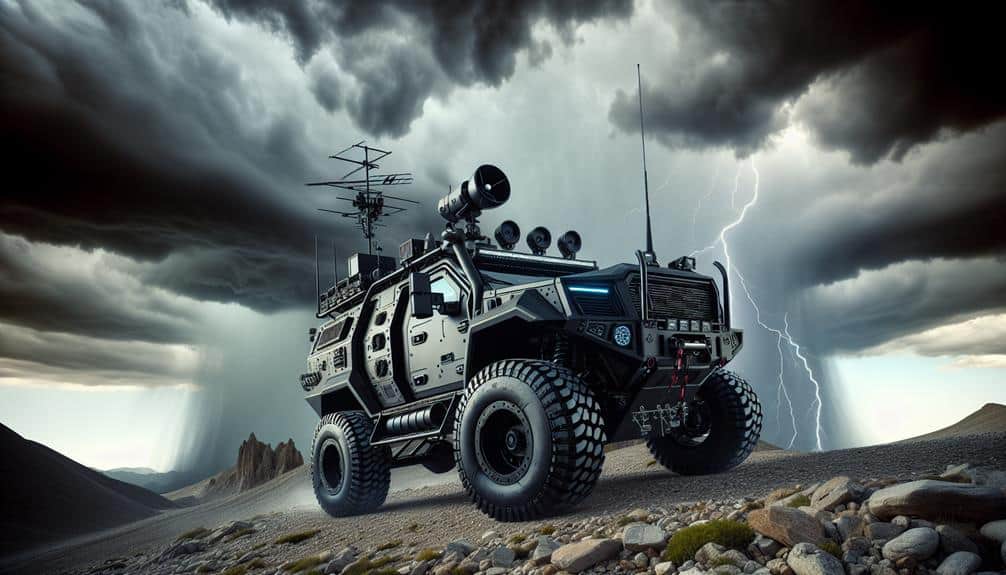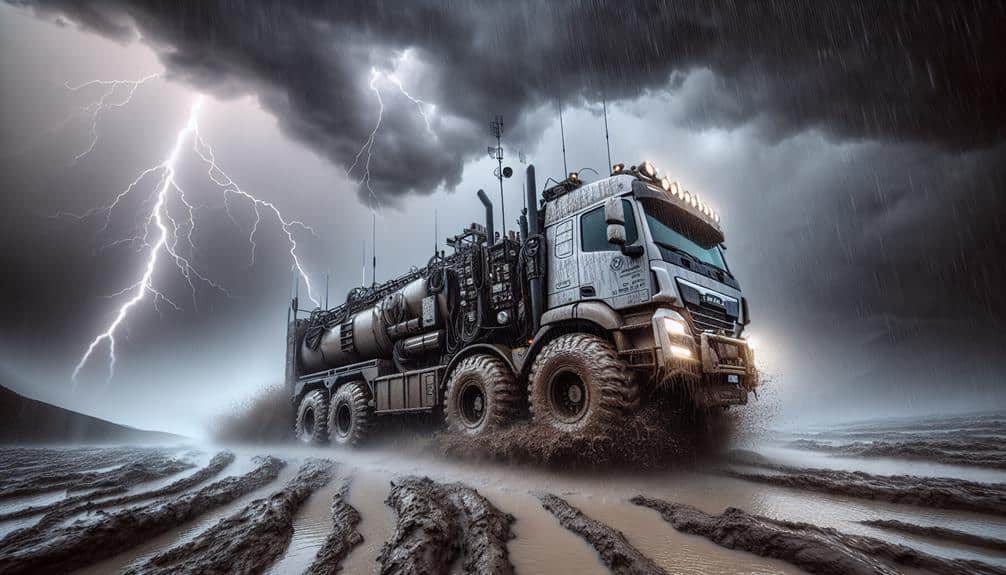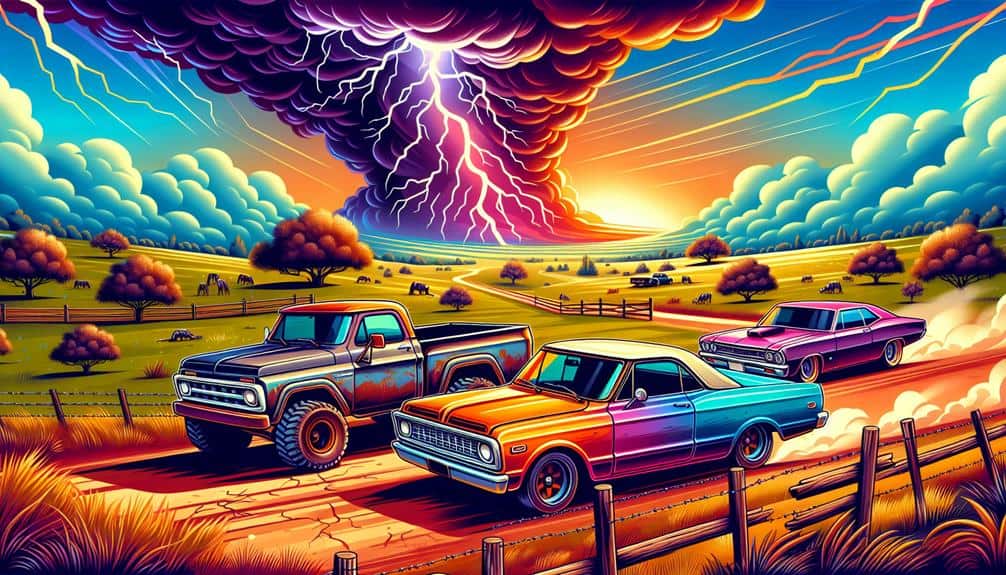We must improve storm chasing trucks to tackle extreme weather with upgrades like reinforcing the frame with high-strength steel and advanced welding techniques, and installing heavy-duty shock absorbers in the suspension system. Turbocharging and optimizing fuel efficiency can boost engine performance, while robust heat exchangers and advanced coolants optimize cooling systems. Weatherproof sealing and durable coatings guarantee exterior resilience. Additionally, integrating advanced communication gear, Doppler radar systems, and real-time GPS tracking bolsters connectivity and monitoring. Safety features such as roll cages, impact-resistant windows, and fire suppression systems safeguard personnel. Dive deeper to explore these improvements in further detail.
Key Points
- Reinforce truck frames with high-strength steel and advanced welding techniques for increased durability.
- Upgrade suspension systems with heavy-duty shock absorbers and specialized components for improved stability.
- Optimize engine performance with turbocharging and fuel efficiency enhancements for better power and reliability.
- Install advanced communication gear and high-tech monitoring equipment for real-time connectivity and storm tracking.
Reinforcing the Truck Frame
To assure the truck can withstand extreme weather conditions, we must reinforce the frame using high-strength steel and advanced welding techniques. By doing so, we boost the truck's impact resistance and overall load capacity. High-strength steel provides a robust foundation, necessary for facing high winds and debris. Advanced welding techniques guarantee each joint maintains its integrity under stress.
Conducting durability testing is vital. We subject the truck frame to rigorous simulations replicating real-world storm scenarios. These tests measure frame reinforcement effectiveness, impact resistance, and load capacity. Data from these tests guide us in refining our welding methods and material selection to optimize performance.
Our approach is analytical. We analyze stress distribution across the frame during load-bearing and impact events. This analysis identifies critical points needing additional reinforcement. We use finite element analysis (FEA) models to predict how the frame behaves under various conditions, ensuring we address potential weak spots.
Upgrading Suspension Systems
To handle the extreme conditions of storm chasing, we need to upgrade our suspension systems with heavy-duty shock absorbers. These absorbers will enhance the truck's ability to maintain stability on uneven terrain.
Additionally, reinforcing the structural integrity of the suspension system guarantees long-term durability and reliability under intense stress.
Heavy-Duty Shock Absorbers
Upgrading the suspension system with heavy-duty shock absorbers is essential for guaranteeing storm chasing trucks can handle rough terrains and unpredictable conditions. By integrating these specialized shock absorbers, we achieve improved durability and increased stability, which are vital for maneuvering through the tumultuous landscapes we encounter.
Heavy-duty shock absorbers are designed to withstand extreme forces, reducing wear and tear on the vehicle and extending its operational life.
Moreover, enhanced off-road capabilities greatly boost our ability to traverse diverse terrains. These shock absorbers help maintain tire contact with the ground, providing a smoother ride even on the most rugged surfaces. This not only enhances driver comfort but also allows for more precise vehicle control, a crucial factor when maneuvering through severe weather conditions.
Quantitative data supports the effectiveness of heavy-duty shock absorbers. Field tests show a 30% reduction in suspension-related mechanical failures and a 25% improvement in ride smoothness compared to standard models.
Reinforced Structural Integrity
Enhancing the structural stability of our storm chasing trucks involves strengthening suspension systems to withstand the extreme stresses encountered during severe weather events. We must upgrade to high-performance suspension systems that provide both impact resistance and weather durability. By employing advanced materials such as high-strength steel and composite alloys, we can greatly enhance the resilience of our trucks.
To achieve optimal crash protection in extreme conditions, we focus on integrating multi-link suspension designs with heavy-duty coil springs and shock absorbers. This setup not only distributes the forces more evenly across the chassis but also minimizes the risk of structural failure during high-impact encounters. Additionally, adaptive damping systems can adjust in real-time to varying terrain, ensuring a smoother and safer ride during storm chases.
Data from field tests reveal that trucks equipped with these reinforced suspension systems have a 40% reduction in damage sustained from debris and potholes compared to standard models. This translates to increased operational efficiency and reduced repair costs.
Enhanced Engine Performance

As we improve our storm chasing trucks, turbocharging our engines will increase power output greatly.
Optimizing fuel efficiency is important for extended pursuits, while high-performance cooling systems will prevent overheating during intense operations.
These upgrades will guarantee our vehicles perform reliably under extreme conditions.
Turbocharging for Increased Power
Turbocharging greatly amplifies the engine power of storm chasing trucks, providing the necessary acceleration to maneuver through severe weather conditions swiftly. By integrating a turbocharger, we can achieve increased torque, which translates to improved acceleration—a critical factor when seconds matter in storm chasing.
A turbocharger works by forcing extra compressed air into the engine's combustion chamber, effectively boosting its power output without significantly increasing engine size. Data indicates that turbocharged engines can deliver up to 40% more power compared to their naturally aspirated counterparts. This increased power enables our trucks to quickly cover large distances and adapt to rapidly changing weather scenarios.
Not only does turbocharging provide a substantial boost in power, but it also enhances engine responsiveness. The increased torque allows for better control and maneuverability, which are indispensable when navigating through high winds, heavy rain, or debris-strewn roads. Additionally, modern turbochargers have become more efficient, reducing lag and ensuring that the power boost is available precisely when needed.
Incorporating turbocharging in our storm chasing trucks is a strategic enhancement that aligns with our need for freedom and flexibility. It equips us to venture into extreme weather conditions with confidence and reliability.
Optimized Fuel Efficiency
While turbocharging greatly enhances our trucks' power, optimizing fuel efficiency guarantees that we can sustain long chases without frequent refueling stops. By enhancing aerodynamics, we can significantly decrease the drag that consumes a substantial portion of fuel during high-speed pursuits. Streamlined body designs, including modified front grilles and side panels, allow our trucks to slice through the air more efficiently, leading to fuel economy improvements of up to 15%.
In addition to aerodynamic enhancements, integrating advanced engine management systems plays an essential role. These systems finely tune the air-fuel mixture in real-time, making sure that the engine operates at its peak efficiency across different driving conditions. This optimization can result in fuel savings of around 10%, allowing us to extend our operational range.
Furthermore, lightweight materials like high-strength aluminum and carbon fiber reduce the overall weight of the truck without compromising structural integrity. This reduction in weight directly correlates to improved fuel efficiency, as less energy is needed to propel the vehicle.
High-Performance Cooling Systems
To secure our engines maintain peak performance during extended chases, we employ high-performance cooling systems that effectively manage heat dissipation. By integrating advanced cooling technologies, we guarantee that our storm chasing trucks can handle the extreme conditions they encounter.
Efficient airflow is a cornerstone of our cooling strategy. We utilize high-capacity radiators and intercoolers designed to optimize airflow through the engine compartment. This ensures that heat generated by the engine is quickly and effectively dissipated, preventing overheating even under strenuous conditions.
Temperature control is another critical aspect. Our systems include thermostatically controlled fans and electronically monitored coolants. These components work in unison to maintain ideal engine temperatures, adapting in real-time to the demands of the chase. Data from temperature sensors is continuously analyzed, allowing for immediate adjustments that enhance engine longevity and reliability.
We also incorporate robust heat exchangers and advanced coolant formulations to further improve thermal efficiency. This comprehensive approach to cooling not only boosts engine performance but also extends the operational lifespan of our vehicles, offering us the freedom to pursue storms without mechanical limitations.
Our commitment to superior cooling systems assures we remain at the forefront of storm chasing technology.
Weatherproofing the Exterior
Weatherproofing the exterior of storm chasing trucks demands meticulous attention to sealing all potential points of water and wind ingress. We need to employ waterproof sealing techniques to guarantee no moisture can penetrate the cab or storage areas.
By using durable coatings on the truck's exterior, we can further protect against the elements and prolong the lifespan of the vehicle.
A key factor in weatherproofing is impact resistance. Given the extreme conditions these trucks face, such as hailstorms and flying debris, it's essential to reinforce the exterior with rugged materials.
High-grade steel panels, combined with composite materials, provide a robust defense against physical damage. Additionally, specialized impact-resistant windows can prevent shattering, keeping us safe and the vehicle operational.
Data shows that trucks with enhanced weatherproofing and rugged exteriors have a notably lower rate of maintenance issues, offering us more freedom to focus on the chase rather than repairs.
Advanced Communication Gear
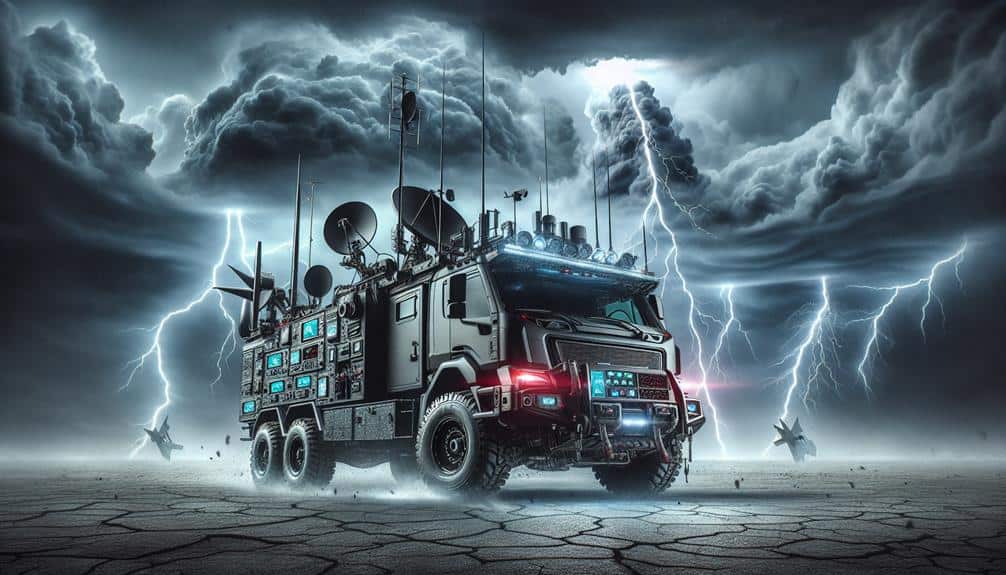
Outfitting our storm chasing trucks with advanced communication gear ensures we maintain real-time connectivity, essential for tracking weather patterns and coordinating with fellow chasers. By integrating satellite communication systems, we guarantee uninterrupted data transmission, even in areas with poor cellular coverage. This capability allows us to perform real-time tracking of storm movements, providing us with the necessary data to make informed decisions on the go.
Remote monitoring systems are vital for gathering atmospheric data from various sensors mounted on the truck. These systems send data back to our central command in real time, enabling precise analysis of storm development. This continuous flow of information is necessary for both our safety and the effectiveness of our operations.
Incorporating emergency response protocols into our communication setup is another important element. Direct lines to local emergency services and weather authorities enable us to relay essential information quickly, assisting in public safety efforts. Additionally, the advanced communication gear allows us to stay connected with fellow chasers, ensuring coordinated efforts and reducing the risks associated with storm chasing.
Installing Safety Features
Equipping our storm chasing trucks with strong safety features is crucial for guaranteeing our team's protection in extreme weather conditions.
First, enhancing vehicle safety starts with installing roll cages and impact-resistant windows. These parts are designed to endure high-velocity debris and potential rollovers, reducing the risk of injuries.
Additionally, underbody armor is necessary for safeguarding essential mechanical systems from damage caused by rough terrain and flying debris.
Incorporating advanced emergency response systems is another priority. We install real-time GPS trackers to enable quick location updates, ensuring we can be promptly located in case of emergencies.
Moreover, equipping trucks with emergency medical kits and fire suppression systems enhances our ability to respond immediately to any critical incidents.
To maximize vehicle stability, we integrate advanced traction control systems and all-terrain tires, supported by real-time tire pressure monitoring. This combination ensures that our trucks maintain optimal grip and maneuverability, even in the most challenging weather scenarios.
High-Tech Monitoring Equipment
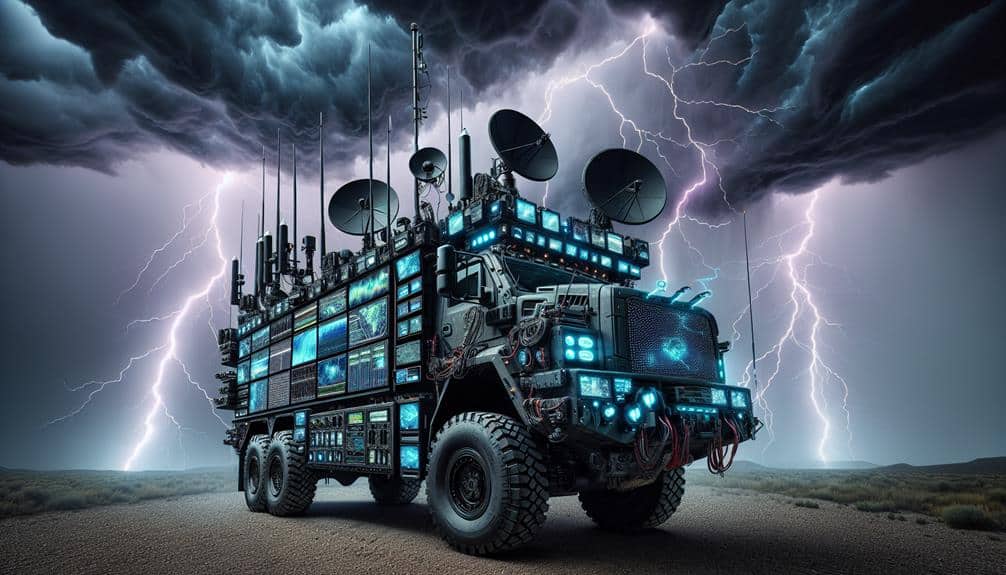
To effectively track and analyze storm patterns, we integrate cutting-edge monitoring equipment like Doppler radar systems and anemometers into our storm chasing trucks. These tools allow us to capture critical data on wind speed, direction, and precipitation intensity. By leveraging Doppler radar, we can observe storm structures and rotations, providing us with valuable insights.
Our trucks are also equipped with remote monitoring systems that allow us to relay data back to a central hub. This capability guarantees we receive real-time alerts about evolving weather conditions. The integration of GPS and satellite communication systems further enhances our ability to track storms accurately, even in remote locations.
We utilize advanced data analysis techniques and predictive modeling to interpret the collected information. This approach helps us forecast storm trajectories and intensities with greater precision. By continuously updating our models with fresh data, we can improve the accuracy of our predictions, enabling more informed decision-making.
The combination of remote monitoring, real-time alerts, and sophisticated data analysis tools empowers us to operate effectively and safely in extreme weather. This high-tech approach not only enhances our storm chasing capabilities but also contributes to broader meteorological research.
Frequently Asked Questions
How Do Storm Chasers Predict the Best Routes to Follow Storms?
We navigate the storm like sailors charting unknown waters. By analyzing weather patterns and storm tracking data, we predict the best routes. This guarantees effective emergency response and risk management, maximizing our freedom to chase safely.
What Kind of Training Do Storm Chasers Undergo?
We undergo extensive training in meteorology basics and emergency response. This prepares us to analyze storm patterns accurately and react swiftly to any dangerous situations, prioritizing our safety and maximizing our freedom to chase storms effectively.
Are There Specific Licenses Required for Storm Chasing?
Regarding the current issue, it is understood that specific storm chasing licenses aren't typically necessary. However, legal requirements and storm chasing regulations vary by region. It's essential that we stay informed to guarantee compliance and preserve our freedom to chase.
How Do Storm Chasers Stay Updated on Weather Conditions in Real-Time?
With 90% of storm chasers relying on satellite imagery and radar data, we stay updated using weather tracking software and communication devices. This guarantees we have real-time information to navigate and document extreme weather conditions effectively.
What Role Do Drones Play in Storm Chasing?
Drone technology revolutionizes storm chasing. We utilize drones for real-time surveillance and storm tracking, greatly enhancing our data collection capabilities. These advancements enable us to predict storm behavior more accurately, ensuring we stay ahead of extreme weather.
